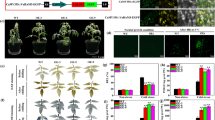Abstract
Late embryogenesis abundant (LEA) proteins are closely associated with the tolerance of diverse stresses in organisms. To elucidate the function of group 3 LEA proteins, the soybean PM2 protein (LEA3) was expressed in E. coli and the protective function of the PM2 protein was assayed both in vivo and in vitro. The results of a spot assay and survival ratio demonstrated that the expression of the PM2 protein conferred the tolerance to the E. coli recombinant for different temperature conditions (4, −20 or 50°C) or high-salinity stresses (120 mmol/l MgCl2 or 120 mmol/l CaCl2). In addition, it was demonstrated that the in vitro addition of the PM2 protein could prevent the lactate dehydrogenase (LDH) inactivation normally induced by freeze–thaw. In the 62°C condition, the PM2 protein (1:5 mass ratio to LDH) effectively prevented the LDH thermo-denaturation by acting synergistically with trehalose (62.5 μg/ml), although the PM2 protein alone at this concentration showed little protective effect on LDH activity. Furthermore, the results showed that the PM2 protein could partially prevent the thermo-denaturation of the bacterial proteome after boiling for 2 min. Based on these results, we propose that the PM2 protein itself, or together with trehalose, conferred the tolerance to the E. coli recombinant against diverse stresses by protecting proteins and enzyme activity under low- or high- temperature conditions.




Similar content being viewed by others
References
Battaglia M, Olvera-Carrillo Y, Garciarrubio A, Campos F, Covarrubias AA (2008) The enigmatic LEA proteins and other hydrophilins. Plant Physiol 148:6–24
Bies-Etheve N, Gaubier-Comella P, Debures A, Lasserre E, Jobet E, Raynal M, Cooke R, Delseny M (2008) Inventory, evolution and expression profiling diversity of the LEA (late embryogenesis abundant) protein gene family in Arabidopsis thaliana. Plant Mol Biol 67:107–124
Dure L (1981) Developmental biochemistry of cottonseed embryogenesis and germination: changing messenger ribonucleic acid populations as shown by in vitro and in vivo protein synthesis. Biochemistry 20:4162–4168
Dure L (1993) A repeating 11-mer amino acid motif and plant desiccation. Plant J 3:363–369
Makarova KS, Aravind L, Wolf YI, Tatusov RL, Minton KW, Koonin EV, Daly MJ (2001) Genome of the extremely radiation-resistant bacterium Deinococcus radiodurans viewed from the perspective of comparative genomics. Microbiol Mol Biol Rev 65:44–79
Tanaka S, Ikedab K, Miyasaka H (2004) Isolation of a new member of group 3 late embryogenesis abundant protein gene from a halotolerant green alga by a functional expression screening with cyanobacterial cells. FEMS Microbiol Lett 236:41–45
Browne J, Tunnacliffe A, Burnell A (2002) A hydrobiosis: plant desiccation gene found in a nematode. Nature 416:38
Babu RC, Zhang JX, Blum A, Ho TD, Wu R, Nguyen HT (2004) HVA1, a LEA gene from barley confers dehydration tolerance in transgenic rice (Oryza sativa L.) via cell membrane protection. Plant Sci 166:855–862
Sivamani E, Bahieldin A, Wraith JM, Al-Niemi T, Dyer WE, Ho TD, Qu R (2000) Improved biomass productivity and water use efficiency under water deficit conditions in transgenic wheat constitutively expressing the barley HVA1 gene. Plant Sci 155:1–9
Zhang L, Akinori O, Masamichi T (2000) Expression of plant group 2 and group 3 lea genes in Saccharomyces cerevisiae revealed functional divergence among LEA proteins. J Biochem 127:611–616
Iturriaga G, Schneider K, Salamini F, Bartels D (1992) Expression of desiccation-related proteins from the resurrection plant in transgenic tobacco. Plant Mol Biol 20:555–558
Wise MJ, Tunnacliffe A (2004) POPP the question: what do LEA proteins do? Trends Plant Sci 9:13–17
Tolleter D, Jaquinod M, Mangavel C, Passirani C, Saulnier P, Manon S, Teyssier E, Payet N, Avelange-Macherel MH, Macherel D (2007) Structure and function of a mitochondrial late embryogenesis abundant protein are revealed by desiccation. Plant Cell 19:1580–1589
Tunnacliffe A, Wise MJ (2007) The continuing conundrum of the LEA proteins. Naturwissenschaften 94:791–812
Goyal K, Walton LJ, Tunnacliffe A (2005) LEA proteins prevent protein aggregation due to water stress. Biochem J 388:151–157
Reyes JL, Campos F, Wei H, Arora R, Yang Y, Karlson D, Covarrubias A (2008) Functional dissection of hydrophilins during in vitro freeze protection. Plant Cell Environ 31:1781–1790
Hsing YC, Chen ZY, Chow TY (1992) Nucleotide sequences of a soybean complementary DNA encoding a 50-Kilodalton late embryogenesis abundant protein. Plant Physiol 99:354–355
Liu Y, Zheng Y (2005) PM2, a group 3 LEA protein from soybean, and its 22-mer repeating region confer salt tolerance in Escherichia coli. Biochem Biophys Res Commun 331:325–332
Lan Y, Cai D, Zheng Y (2005) Expression in Escherichia coli of three different soybean late embryogenesis abundant (LEA) genes to investigate enhanced stress tolerance. J Integr Plant Biol 47(5):613–621
Yu Y, Sun H, Zheng Y, Lan Y, Xu S, Tang Y, Ma X (2004) Isolation and characterization of genes related to salt-tolerance in soybean. J Shenzhen Univ 21(4):324–330
Liu D, Lu Z, Mao Z, Liu S (2009) Enhanced thermotolerance of E. coli by expressed OsHsp90 from rice (Oryza sativa L.). Curr Microbiol 58:129–133
Kovacs D, Kalmar E, Torok Z, Tompa P (2008) Chaperone activity of ERD10 and ERD14, two disordered stress-related plant proteins. Plant Physiol 147:381–390
Kandror O, DeLeon A, Goldberg AL (2002) Trehalose synthesis is induced upon exposure of Escherichia coli to cold and is essential for viability at low temperatures. Proc Natl Acad Sci 99:9727–9732
Sahi C, Singh A, Kumar K, Blumwald E, Grover A (2006) Salt tolerance response in rice: genetics, molecular biology, and comparative genomics. Funct Integr Genomics 6:263–284
Hara M, Shinoda Y, Tanaka Y, Kuboi T (2009) DNA binding of citrus dehydrin promoted by zinc ion. Plant Cell Environ 32:532–541
Acknowledgments
This work was supported by the National Science Foundation of China (30470107, 30670180, 30811130217), and SZU R/D Fund (200630).
Author information
Authors and Affiliations
Corresponding author
Rights and permissions
About this article
Cite this article
Liu, Y., Zheng, Y., Zhang, Y. et al. Soybean PM2 Protein (LEA3) Confers the Tolerance of Escherichia coli and Stabilization of Enzyme Activity Under Diverse Stresses. Curr Microbiol 60, 373–378 (2010). https://doi.org/10.1007/s00284-009-9552-2
Received:
Accepted:
Published:
Issue Date:
DOI: https://doi.org/10.1007/s00284-009-9552-2




